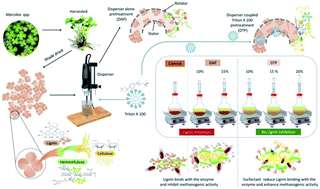Profitable disperser coupled surfactant pretreatment of aquatic phytomass for energy efficient solubilization and biomethanation: a study on lignin inhibition and its possible solutions
Abstract
This study aimed to evaluate and compare how the different solubilizations induced by two pretreatment methods (disperser assisted pretreatment (DAP)) and disperser coupled Triton X 100 pretreatment (DTP) impact the biomethanation, biodegradability and feasibility of aquatic phytomass (Marsilea sps.). In DTP, the coupling of the surfactant with the disperser prevents the binding of soluble lignin with methanogenic enzyme and enhances methane production during biomethanation. The outcome of biodegradability and biomethanation confirmed that 20% solubilization through the DTP process was proficient to achieve improved biodegradability and methane production of about 0.33 gCOD gCOD−1 and 0.337 L gCOD−1 when compared to DAP (achieving 20% solubilization was impossible via DAP). An energy and cost assessment proved that achieving 20% solubilization through DTP was profitable on the basis of energy and cost-benefit ratios (1) when compared to DAP.



 Please wait while we load your content...
Please wait while we load your content...